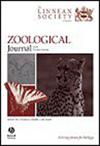有两根羽毛的'鸟':Avicranium renestoi 和鸟头类爬行动物(双翅目:'Avicephala')的类群划分
IF 3
2区 生物学
Q1 ZOOLOGY
引用次数: 0
摘要
我们重新审视了晚三叠世雷盘龙类的解剖结构,重点研究了之前发表的北美诺尔纪Avicranium renestoi主模式的表面模型。我们对该类群的头骨解剖进行了评论,并提出了新的头骨和下颌骨重建方案。与之前的解释相反,该标本没有保留整个喙和大部分上颚。我们还认为,一些拟议的多形性特征可能是由于不成熟导致骨化不完全造成的。这些新的观察结果被编入一个新的形态学系统发育数据集,旨在解决 "Avicephala "的单系问题,该类群包括晚二叠世滑翔爬行动物 Weigeltisauridae 和晚三叠世变色龙类 Drepanosauromorpha。我们认为魏格龙科是茎龙类中的双翼龙科,而雷盘龙科则是古龙类中三叶龙科的姊妹类群,从而暗示了 "Avicephala "的旁系性。在头骨和颅骨同形异构的支持下,雷盘龙科和三棘龙科首次成为姊妹群。这一新的Drepanosauromorpha的系统发育位置减少了该类群的幽灵系,现在幽灵系并不一定跨越二叠纪-三叠纪界线。然而,三叠纪弓龙目爬行动物的早期历史和树栖性的演化仍有许多未知。本文章由计算机程序翻译,如有差异,请以英文原文为准。
‘Birds’ of two feathers: Avicranium renestoi and the paraphyly of bird-headed reptiles (Diapsida: ‘Avicephala’)
The anatomy of Late Triassic drepanosauromorphs is re-examined, with a focus on the previously published surface models of the holotype of Avicranium renestoi from the Norian of North America. We comment on the cranial anatomy of this taxon and propose a new reconstruction of the skull and mandible. Contrary to previous interpretations, the entire rostrum and most of the palate are not preserved in this specimen. We also suggest that some proposed plesiomorphic characters may result from incomplete ossification due to immaturity. These new observations are compiled into a new morphological phylogenetic dataset designed to address the monophyly of ‘Avicephala’, the group comprising the Late Permian gliding reptiles Weigeltisauridae, and the Late Triassic chameleon-like Drepanosauromorpha. We recover Weigeltisauridae as stem-saurian diapsids and Drepanosauromorpha as sister-group to Trilophosauridae among archosauromorphs, thus implying the paraphyly of ‘Avicephala’. Drepanosauromorphs and trilophosaurids are recovered as sister-taxa for the first time, as supported by several cranial and postcranial synapomorphies. This new phylogenetic position of Drepanosauromorpha reduces the group’s ghost lineage that now does not necessarily cross the Permian–Triassic boundary. However, much remains unknown of the early history of trilophosaurids and drepanosauromorphs, and of the evolution of arboreality in Triassic archosauromorph reptiles.
求助全文
通过发布文献求助,成功后即可免费获取论文全文。
去求助
来源期刊
CiteScore
6.50
自引率
10.70%
发文量
116
审稿时长
6-12 weeks
期刊介绍:
The Zoological Journal of the Linnean Society publishes papers on systematic and evolutionary zoology and comparative, functional and other studies where relevant to these areas. Studies of extinct as well as living animals are included. Reviews are also published; these may be invited by the Editorial Board, but uninvited reviews may also be considered. The Zoological Journal also has a wide circulation amongst zoologists and although narrowly specialized papers are not excluded, potential authors should bear that readership in mind.

 求助内容:
求助内容: 应助结果提醒方式:
应助结果提醒方式:


